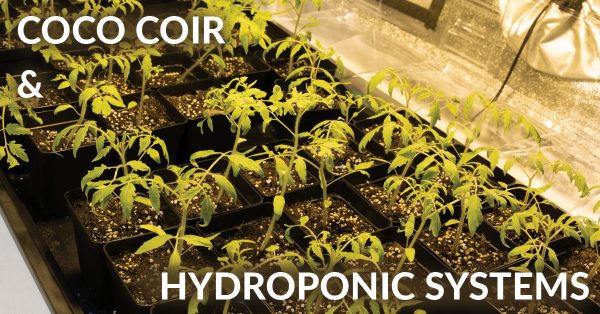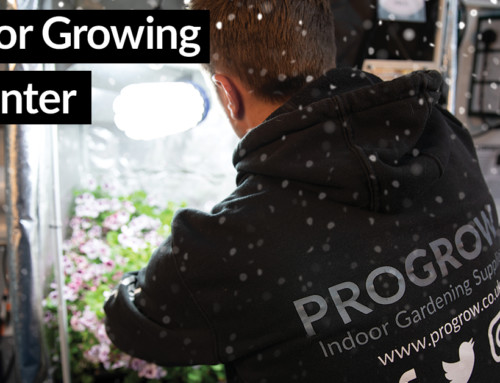What is Coco?
Coco coir is a recycled and processed natural fibre from the husk of coconuts. These fibres are stringy, allowing great access to oxygen for your plant’s roots. Coco looks and feels similar to soil, but has no nutrients in it.
Pros of using Coco:
• Plants grow faster, creating bigger yield and drain faster than in soil.
• Even when soaking wet, coir is 20 % air that means the roots are happy and healthy.
• Coco holds onto nutrients well therefore uses less nutrient.
• Coco has anti-fungicidal properties therefore creating less chance of root rot, (It will also repel some pests).
• Easily renewable source meaning its eco-friendly.
• It’s more tolerant of mistakes than NFT or DWC.
Cons:
• Not as fast growth as Deep-water culture or NFT.
• As with soil, there is medium to get rid of after a grow.
• There is less room for error than soil.
• Calcium and magnesium deficiencies can be more common in coco than in soil.
4 Hydroponics systems that can be used with coco
1. Hand Watering
You can hand water coco, as you would soil; however, you need to have 10-30% of the feed running out the bottom of the pot. This is because coco holds onto salts, these build up at the base of the pot, so will need flushing. A layer of pebbles in the bottom of the pot can help with this.
Tips:
• Feed until you see water coming out bottom of pot, throw away this excess (runoff).
• Check the EC of the runoff, if comes out higher than you put in, feed the plant just plain water next time.
• An inch-deep layer of pebbles in the bottom of the pot will help with drainage.
Pros:
• Almost as simple as soil growing.
• Higher yields than soil.
• Faster growth than soil.
Cons:
• Not as forgiving as soil – you must monitor pH and EC.
• Can suffer from nutrient lock due to the way coco holds on to some metals.
2. Re-circulating Dripper system
Dripper spikes are stuck into the surface of the coco, down in around the plant root zone. A pump, usually on a timer, feeds the plant through these. The timer can be a cheap, segmental 15minute timer. The plant takes up the nutrient and water it wants, then the excess drips out of the bottom of the root zone, back into the feed tank. The most common re-circulating systems is the Wilma systems . You can also set up our Run To Anywhere system to work this way.
In a re-circulating system, you must check the EC and pH of the tank daily. On a hot day your plants may want to drink plain water, this will raise the EC in your tank, possibly to harmful levels. An EC of 2.0 is as high as you want it to go. Sometimes your plants will be more hungry than thirsty, they will pull the nutrient they want from the tank, which will lower the EC. All of this also causes the pH to fluctuate, so you need to check daily that it is between 5.2 -6.5.
Pros:
• Straight forward to set up.
• Can use less nutrient.
Cons:
• Unused nutrients stays in your tank, taking up room in the water.
• Daily checks of EC and pH are needed for good results.
• Water can get too warm in tank as it’s in grow space under lights.
• When topping up your tank, you cannot tell what nutrient is in there, you only have a rough guide to how much nutrient is in there ( from checking EC ).
• Tank must be emptied and refilled once a week.
Tips:
• Aim to set the pH of your tank to 6.2. Do not worry if you are slightly out. It’s better to be slightly out than to fill your tank up with excess pH down (acid) and pH up (alkali).
• Do not keep adding pH up and pH down to get to exact 6.2. Somewhere between pH 5.5 – 6.5 is fine. If you are way outside of this range, empty the tank and start again.
• Set EC to 1.6 maximum to allow room for EC to rise as your plants drink water.
• If you tank reads above 2.0m, you can lower the EC with plain water as a quick fix.
• Empty your tank once a week, same day each week. Your plants will love you.
• Keep water temperature as near to 18 degrees Celsius as possible.
• Record the fluctuations in pH and EC, it will help you learn. It will also help your local grow shop give you advice. The more information you give us, the more we can help you.
3. Run To Waste
Run to waste is the professional’s method of choice. This is the most effective and efficient way to grow in Coco. You fill the feed tank up with the correct nutrients, in the correct ratios and at the correct strength.
Your plants get fresh nutrient each time, the waste nutrient they don’t feel like eating, the “run off”, drains away, not to be seen by the plants again.
Our Return To Anywhere (RTA) system is a popular system to use. You set it up to act as a “Run to Waste” system by plumbing the waste pipe to pump out into a waste tank, separate from the feed tank.
The drippers are set up in the same way as a re-circulating system. You need to be more precise with the timing of the feed pump, as you do not want to waste nutrients. For this reason, it is advisable to use a digital timer. You will need the ability to set the pump to feed for a minute at a time. Our RTA systems come with a Nutrimatic Timer. These come semi pre programmed and can be adjusted to 1 second feed at a time.
In a run to waste system, you fill the nutrient tank up to the correct pH and EC, then ensure it is kept as close to 18 degrees Celsius as possible. You should not need to adjust the feed once this is done.
Set the timer so that 20% of the feed fed to the plants ends up in the waste tank. So, if you have a 100l nutrient tank, after emptying it, 20l of water should be in your waste tank.
Pros:
• You don’t need to be there every day.
• Feed doesn’t need constant adjusting.
• Higher yields.
Cons:
• Uses more nutrient.
• Bit more complicated to set up.
Tips
• Use Air –Pots or Fabric Pots for best root development.
• Clean the inline filter and filter in the dripper manifolds weekly at a minimum.
• Measure the EC and pH of the “run off” in your waste tank. This will give you a good idea of how much nutrient your plants are taking up. If EC in waste tank is much weaker than nutrient tank – raise the EC in nutrient tank.
• If you have a favourite booster that is thick and treacly, top feed it by hand – this will prevent blockages.
4. Gravity Fed Systems
The most popular gravity feed system is the AutoPot system. There is a clever valve that only allows ½” of water to fill in the tray, this doesn’t refill until the plant has taken it up.
Pros:
• Simple.
• No risk of pump failure as gravity fed.
• No daily adjustments of feed.
Cons:
• Less air gets to roots.
• Dripper lines can block if not flushed regularly.
• Can’t use most organic feed.
• Can’t use some some of the thicker additives.
Tips
• There is a small rubber grommet in the Autopot valve. To find it, lift up the float section, it is a 5mm diameter, 5mm long tubular soft rubber insert. Different valves have different colour grommets, but it is easy to find. Pull it out and rub it between your fingers, put it back in. This “primes” it.
• Top feed for first couple weeks to get a good root system developed.
• Fill bottom of pots with an inch of cleaned expanded clay pebbles, Gold Label 45l bags are recommended.
• Keep a circulation pump in the nutrient tank “bleed off” the feed lines once a week to prevent salt build up in lines.
• Use only clean nutrients, if they are thick and gloopy, they will block the valves and thin lines.
• Use “Auto-Pot Air-Domes” for extra oxygen to roots.





Leave A Comment